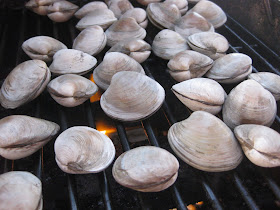
For me, eating seafood at the beach is much more fun than in the city because, as you’ve probably figured out, I love to be close to my food source. On the Outer Banks where we are surrounded by the sea and sound, it’s ridiculously easy to get seafood that is fresh from the waters that day or the day before.


My oyster recipe comes courtesy of Frank Stitt, chef and owner of what is said to be one of the best restaurants in the South, Birmingham’s Highlands Bar and Grill. I first heard about him in a Town and Country article about Southern chefs changing the way Americans think about food. I bought his incredible cookbook, Frank Stitt’s Southern Table, and discovered he is a wonderful storyteller whose Southern charm shines through in his descriptions and recipes. But don’t be fooled; behind his charm lies a serious chef.
Born in Cullman, Alabama to a surgeon father and glamorous mother who also happened to be the best cook in town, the family tagged along with Dad when he went to medical conferences, eating at the finest restaurants in New Orleans, Chicago, and New York. This, combined with everyday exposure to Mom’s authentic Southern cooking, laid the foundation for what was to come. Perseverance and an alignment of stars (I’m sure the charm helped, too) allowed him to learn from some of the 20th century’s original locavore chefs; Alice Waters, Richard Olney, Elizabeth David, and Jeremiah Tower.
Reading the book, I was drawn in by his humble appreciation for impeccable, fresh ingredients, purchased from local Alabama and Gulf Coast purveyors and used to make traditional Southern foods like sweet potatoes, butter beans, crawfish, and shrimp sophisticated. He says it best:
“This cookbook is about cooking from the heart and soul with knowledge, dedication, and harmony. Balance, complexity, and simplicity are what we’re after. And sharing food at table is ultimately about sharing one’s love for life.”

The oysters I used were from the Chesapeake Bay, the James River specifically. As I mentioned in a previous post, we drive over the Bay on our trip down to OBX. It is a beautiful region deserving a trip of its own rather than just a drive through. Sadly, the Chesapeake Bay, North America’s largest estuary and long rich in all types of fish and shellfish, is in serious trouble. The usual suspects of suburban sprawl, overfishing, pollution from boats and pesticide run-off have done their best to kill off all that is living in the Bay watershed. Remember the pesticide spraying tractor and crop dusters I talked about seeing as we drove through Accomack County? Uh-huh - that pesticide ends up in the Bay.
Since colonial times, the Chesapeake has lost 98 percent of its oysters. Healthy, robust oyster reefs are key to the Bay cleanup; a single oyster filters 50 gallons of water a day and the reefs provide habitat for marine life. An experimental reef set up 5 years ago near the mouth of the Great Wicomico River, just south of the Potomac, shows promise. It is currently home to 180 million native oysters, which sounds impressive until you realize in the 1800’s the Bay was home to billions of oysters.
The Chesapeake Bay Foundation, started over 40 years ago, exists to “prod and assist the government in dealing with the impacts of 17 million people on its watershed”. While they have had success in their stated mission, there is still a long way to go to turn the tide, so to speak, and bring back a vibrant Bay ecosystem.
Spicy Baked Oysters with Caramelized Onions
From Frank Stitt’s Southern Table

I’ve eaten oysters before but never shucked one myself so I googled instructions. I had heard it wasn’t the easiest task but wasn’t particularly worried until coming across comments online like “It took me 10 minutes – EACH”. That’s when I started to sweat. Turns out, my panic was completely unnecessary. Yes, the first couple took a few minutes - each - but once I got the hang of it the oysters were done in a flash.

Next time I make this (and I will make this again!) I’ll cut back a little on the bacon and make sure I have real breadcrumbs on hand rather than the kind that looks like sand and comes out of a can. That’s just wrong!
This is really easy and really impressive. It’s a burst of flavors in your mouth – salt, spice, smoke, sweetness. Delicious.
Ingredients
1 tablespoon olive oil
2 onions, quartered and thinly sliced
Kosher salt and freshly ground pepper
Rock salt for serving
24 oysters, such as Apalachicola, bluepoint, Pemaquid, Chesapeake, or Malpeque, shucked and let in the bottom shells
8 tablespoons (1 stick) unsalted butter
Coarsely ground dried hot chile or cayenne pepper to taste
6 to 7 very thin slices pancetta, cut into twenty-four 1 ½-inch squares, or 6 slices bacon, preferably center-cut, cut into 4 pieces each
1 cup medium-coarse bread crumbs
Preheat the oven to 450 F.
Heat the oil in a medium skillet over medium-high heat. Add the onions and cook, stirring often, until golden, about 15 minutes. Season with salt and pepper and set aside.

Make a bed of rock salt on a baking sheet and arrange the oysters on top. Top each with a little of the sautéed onion – just enough to cover. Place a teaspoon of butter and a good pinch of chile on each, then top with a square of pancetta (or bacon) and a scattering of bread crumbs to finish.
Bake until the pancetta is slightly crispy, the bread crumbs golden, and the oysters heated through, 10 to 12 minutes.
Serves 4

No comments:
Post a Comment
Note: Only a member of this blog may post a comment.